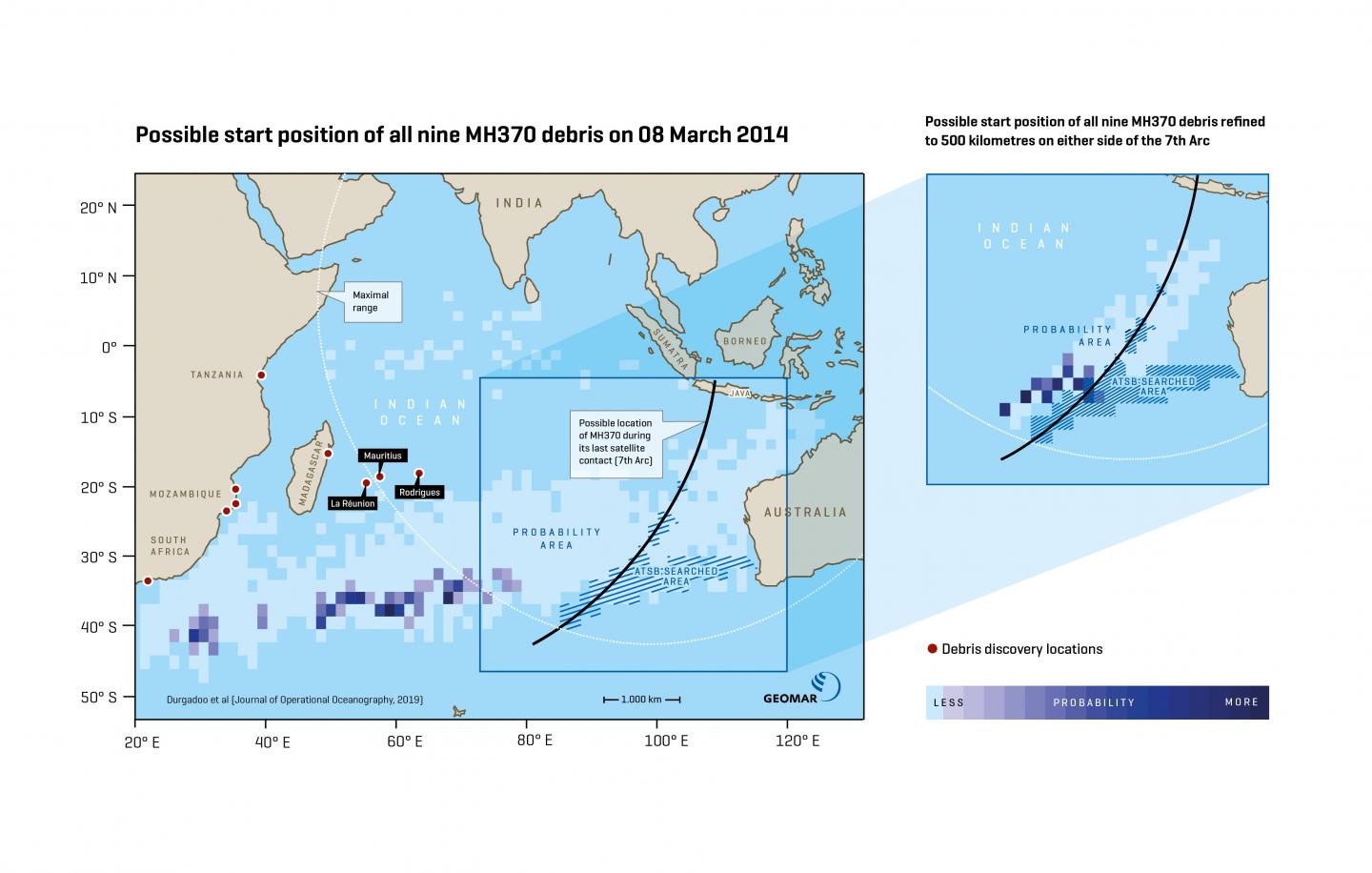New strategies for tracking of marine objects proposed

Credit: Source: C. Kersten, GEOMAR
The precise last position of the Boeing 777 of Malaysia Airlines (MH370) that disappeared from radar screens on 8 March 2014 is still unknown. Multiple large-scale search missions have failed. The discovery of several items of debris along the shore of the western Indian Ocean in the subsequent years had brought renewed hope. Shortly after the sighting of the first piece of debris, a flaperon on La Réunion in 2015, a team of scientists at GEOMAR Helmholtz Centre of Ocean Research Kiel started to simulate its possible drift in the hope of narrowing down the area of the possible crash site. A few months later, a European consortium was able to refine the calculations by adding the effect of surface waves. Their result: the most likely crash-site region of the MH370 is located west of Australia, north of the then search area.
Since then, even after the end of the search effort, the researchers under the leadership of GEOMAR in co-operation with the UK’s National Oceanography Centre (NOC), the Mercator Océan group in Toulouse and the European Centre for Medium-Range Weather Forecasts (ECMWF) in Reading continued their work on simulating the drift of marine debris. The goal was to establish strategies for future quasi-real-time applications of the drift of objects or organisms in the ocean. In their quest, they addressed the importance of considering surface waves in the calculations, of using advanced simulation techniques and statistics, and whether or not the use of more pieces of debris would refine their results.
From their point of view, in addition to surface ocean currents and wind, the so-called “Stokes drift” is also of central importance for the drift of objects in the uppermost layer of the ocean surface. Stokes drift describes the net movement of floating objects caused by the passing of surface waves. The recent study proves that Stokes drift is much more important for analysis than previously assumed. “Ignoring Stokes drift in the simulations can lead to major errors, as we have demonstrated with the MH370 example. For any application where surface drift is studied, Stokes drift should be included to provide more precise tracking results”, explains Dr. Jonathan Durgadoo of GEOMAR, lead investigator of the study.
The research team assessed the differences in using the methods of forward- and backward-tracking in time. The path of an object can be traced back in time or can be predicted. “The different tracking approaches provide a robust methodology and enable an assessment of uncertainties. These can be minimised by simulating sufficient numbers of virtual objects”, continues Jonathan Durgadoo.
In the case of MH370, the research team also extended their initial analysis, which was based solely on the flaperon found on La Réunion in 2015, to also include other items of debris that were recovered in other locations. Despite considering these other wreckage parts, the crash area could not be refined. The research team surmises that more knowledge of the buoyancy characteristics of the debris is required. They further acknowledge the uncertainty in estimating the time difference between the washing up of debris on land and their recovery. “Unfortunately, no further information is available to us. Our current estimations suggest that, with at least five items of debris, an optimal area for the most probable crash-site region can be achieved”, emphasises Prof. Dr. Arne Biastoch, head of the research team at GEOMAR.
However, there is very little hope for new information on the drift characteristics of the debris. Dr. Jonathan Durgadoo still draws a positive balance: “The exercise of estimating the surface drift of debris from MH370 has led to an improved preparedness for future applications”.
“The study also demonstrates the strength of the European partnership we have developed through our shared use of the NEMO ocean modelling framework” adds Prof. Dr. Adrian New of the UK’s National Oceanography Centre.
According to the research team, the results obtained from the MH370 case can also be applied to completely different surface drift simulations. For example, it is also possible to track and predict more accurately the spread of plastic waste or of passively drifting organisms such as fish larvae or plankton.
###
Media Contact
Andreas Villwock
[email protected]
Related Journal Article
http://dx.




